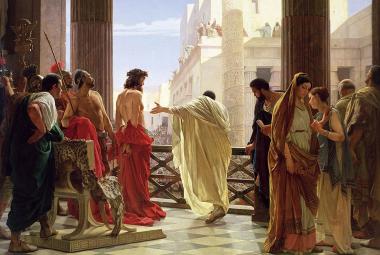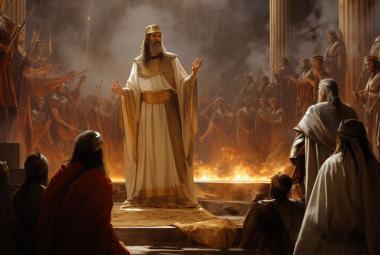What Is the Definition of Ekklesia?
The Greek word ekklesia, which is often translated “church” in the New Testament, means “a gathering of citizens called out from their homes into a public place—an assembly or any gathering or throng of men assembled by chance, tumultuously.”1
In Volume Four of Dr. Norman Geisler’s Systematic Theology he states:
In classical Greek, ekklesia referred to an assembly of any kind, religious or secular, lawful or unlawful. The Hebrew words qahal and edhal, often translated as “ekklesia” in the Greek Old Testament, meant a gathering or assembly such as Judaism eventually had in the synagogue.2
The Greek word ekklesia occurs in the following Scripture passages:
- The word is used in Acts 19:32, 41 of an assembly (ekklesia) of Diana worshippers.
- It is used in Acts 19:39 as a “lawful” assembly (ekklesia) or court, which could be gathered to hear the matters against Paul.
- It is used in the above referenced passage (Acts 7:38) by Stephen referring to the assembly (ekklesia) of Israelites in the wilderness, who as a nation (not individually) were the people of God. We know that only a remnant were truly the people of God because when Moses said “Who is on the Lord’s side? Let him come unto me.” Only the sons of Levi gathered themselves together unto him (Exodus 32:26).
- In the Septuagint (LXX—Greek translation of the Old Testament) it is used of the Israelites in one big group and sometimes of specific smaller groups. Throughout the Old Testament there was always a remnant that was truly the people of God while the rest of the nation was not.
- In the LXX it is used in 1 Samuel 19:20 of an ekklesia of prophets.
- In the LXX it is used in Psalm 26:5 for an ekklesia of evil doers.
- In the LXX it is used in Ezekiel 32:3 of an ekklesia of many people (not Israel) coming against Egypt.
- And finally, in the New Testament it is used to refer to a specific ekklesia, The Ekklesia belonging to the Lord Jesus Christ.
In the context of the Scriptures listed, it is clear the use of the Greek word ekklesia does not automatically translate to the Ekklesia of Christ, which is a specific ekklesia.
The Ekklesia Belonging to Christ
The first mention of Christ’s Ekklesia is a quite famous passage in Matthew 16:18, where Jesus states:
And I say also unto thee, that thou art Peter (a stone), and upon this (large) rock I will build my church (ekklesia); and the gates of hell shall not prevail against it.
Matthew 16:18
This is a specific ekklesia, Christ’s Ekklesia. It is built on the foundation of the Apostles with Jesus as the chief cornerstone (Ephesians 2:20). This did not exist before Christ. Jesus states—future tense—that He will build His Ekklesia. It is important to note that He also does not say that this would be adding to something that already existed.
According to 1 Corinthians 12:13, this Ekklesia is comprised of believers ONLY, who are baptized by ONE Spirit into ONE body.
For by one Spirit are we all baptized into ONE body, whether we be Jews or Gentiles, whether we be bond or free, and have been all made to drink into one Spirit. For the body is not one member, but many.
1 Corinthians 12:13
As indicated in Ephesians 1:19-23, the resurrection was a prerequisite for the existence of the Ekklesia. He became the head of the Ekklesia by virtue of His resurrection.
And what is the exceeding greatness of his power toward us who believe, according to the working of his mighty power. Which He wrought in Christ, when he raised Him from the dead and set him at his own right hand in the heavenly place, Far above all principality, and power, and might, and dominion, and every name that is named, not only in this world, built also in that which is to come. And hath put all things under his feet, and gave him to be the head over all things to the Ekklesia (church), which is his body, the fullness of him that filleth all in all.
Ephesians 1:19-23
One New Man
In Ephesians 2:15-16, Paul said that Christ made it possible, through His death on the cross, for the Jews and the Gentiles to join together into “One New Man.” They joined together as a singular, never before existing entity, one body—the body of Christ.
Having abolished in his flesh the enmity, even the law of commandments contained in ordinances; for to make in himself of twain one new man, so making peace; and that he might reconcile both unto God in one body by the cross, having slain the enmity thereby.
Ephesians 2:15-16
However, Christ’s Ekklesia has been divided for various reasons starting as early as the 2nd century A.D., when the increasingly Gentile-dominated church began to insist that Jews must renounce everything Jewish to become Believers. In essence, the Gentile church was attempting to turn Jews into Gentiles.
This is an impossibility, however. According to the Scriptural definition of a Jew, you must be a physical descendent of Abraham, Isaac, and Jacob. (Although the term “Jew” is used by some denotatively as one from the tribe of Judah or from the Old Testament Southern Kingdom, throughout this article it is used in its common connotative meaning—anyone who is a descendent from the 12 tribes of Israel.) This should not be confused with Judaism, which is the religion practiced by Jews.
Likewise, the Scriptural definition for a Gentile is anyone who is not a physical descendent of Abraham, Isaac, and Jacob. Gentiles practice many different religions and have many different ethnicities, but it is their non-Jewishness that makes them “Gentile.”
This attempt to turn Jews into Gentiles forced those Jews who refused to follow this unscriptural practice to segregate into “Jewish believer only” congregations and resulted in persecution by their own Christian brothers and sisters. With few exceptions, this continued throughout the past 2000 years.
Covenant Theology
The teachings of Covenant Theology in its two forms, Post-millennial and Amillennial, both reflect the belief that the Jews, as a nation, have been replaced at some point in time. Central to this belief is that there has been, is, and always will be ONLY one people of God. In other words, the Nation of Israel and the Ekklesia of Christ cannot coexist as separate peoples of God.
Covenant Theologians read the Ekklesia back into the Old Testament as the Nation of Israel. They believe that the Nation of Israel was a manifestation of the Ekklesia in some form and then when Christ came, the nation of Israel no longer were the people of God. In essence, they teach that the People of God have always been the Ekklesia, are the Ekklesia, and will always be the Ekklesia of Christ. On the surface, this seems plausible. However, upon further examination, this proves to be a wrong assumption.
The Modern-Day Division of the Ekklesia
Although understanding our Jewish roots is beneficial and even essential, there is a difference between understanding our Jewish roots and going back(wards) to our Jewish roots. Understanding our Jewish roots builds up the church and helps to unify it, but going back divides it in two. Unfortunately, many who began with a love for the Jewish people and both a desire to understand their Jewish roots and fellowship with Jewish believers gradually move from this Scriptural pursuit and begin to adopt unscriptural doctrines and practices.
As stated earlier, Covenant Theology teaches that the Ekklesia of Christ has always existed as the People of God. However, now the reverse is being taught by many (not all) Messianic groups and organizations, Jewish roots teachers, and Two-House proponents. Like the Covenant Theologians, they teach that there has always only been one “People of God.” However, in contrast to Covenant Theology they believe it always has been, is now, and always will be Israel.
The single characteristic common to both Covenant Theologians and many Messianic/Jewish Roots/Two House teachers is that they DO NOT believe that the Ekklesia of Christ is a separate entity. But as shown earlier, the Ekklesia is indeed a separate entity, which began after the death and resurrection of Jesus Christ.
The resulting situation amounts to the opposite of what occurred in the 2nd century Gentile-dominated church. These groups insist that Gentiles become like the Jewish Messianic believers or, in the case of Two-House teaching, that Gentile believers actually are descendents of Joseph and Ephraim; if not physically, at least in a spiritual sense.
Eventually, many of these believers voluntarily segregate themselves from other believers by attending Messianic congregations only, and distancing themselves from anything relating to what is often referred to as the “Gentile Church.”
The majority of those attending these Messianic congregations are Gentiles, with a small percentage of Jewish believers. In his book, Messianic Judaism Is Not Christianity, Stan Tel-chin, a Messianic Jew and retired pastor of 14 years states:
As reported by almost all who have experienced the [Messianic] congregations, the overwhelming majority—sometimes as much as 85 to 90 percent of the attendees—are Gentiles.3
In his book, he relates a number of testimonies by people who have attended Messianic synagogues attended by large numbers of Gentiles. He states that based upon what he had observed over the years in Messianic congregations, “God’s love and grace are secondary to the emphasis upon Jewishness.”4
He also quotes a woman who had attended a Messianic synagogue for over two years with her Jewish husband who states: “Week after week I would anguish over the emphasis on Jewishness rather than “Jesusness.”5
While Gentiles joining with Jewish believers can be seen as a step in the right direction, some of these groups have progressed in an unscriptural direction. Some of the Gentile believers in these groups feel that to be a Gentile is to be a second class believer. Many seem to be so enamored by the symbols, customs, celebrations and all that is part of Judaism that they as Gentiles are jealous of the Jews and want to become like them.
Provoke to Jealousy?
In direct contrast, Romans 11:11 states that “Salvation has come unto the Gentiles, for to provoke them (the Jews) to jealousy.”
Dr. Arnold Fruchtenbaum explains that the Greek word parazelao, which is translated “provoke them to jealousy” is a combination of two Greek words para, meaning “to come alongside of” and zelos, meaning “to cause to burn, to seethe, to make red hot, to flame, to envy”:
The picture is that the Gentile Christian is to come alongside a Jew (para) in daily contact and to live such a life and be such a witness that the Jew will begin to burn with red hot envy (zelos) so that he will want the very thing the Gentile Christian has: The Jewish Messiah.6
The Solution—True Unity
By dividing the body of Christ into two, the Ekklesia has lost spiritual blessings, fellowship with Jewish believers, doctrinal unity, and possibly even effectiveness. In his book Hebrew Christianity, Dr. Fruchtenbaum lists a number of things Christ’s Ekklesia has lost because of separating the body of Christ in two and should become a part of the Ekklesia once again:
- The ability of the Jewish believers to contribute to the growth of the church through the use of his or her spiritual gifts.
- The ability to educate the Gentile believers in their obligation to the Jew and Jewish missions.
- A Jewish perspective on Scriptures. There are many passages of Scripture which are peculiarly Jewish and which only a person with a Jewish background would be able to explain, such as the two cups mentioned in Luke 22:14-20 in connection with the Passover. His very presence is a witness to the Jewishness of the Christian faith, of the Scriptures, and of the Savior.
- The Jew in the church can be the discerner between the teaching and mores in the church that are truly Scriptural and those that are not. He can be the one to distinguish between what is Biblical and what is really a product of Gentile culture.
- The Jew can stem the tide of anti-Semitism by teaching what God feels about one’s attitude to the Jews and by teaching the church how to receive the Hebrew Christian and be sensitive to his problems as a new believer.7
Dr. Fruchtenbaum then states:
The teaching of Scripture is against both total separation from the local church and separation by forming strictly Hebrew Christian congregations. The local church must be composed where possible of both Jewish and Gentile believers working together for the cause of Christ.8
Jesus never intended for His body to be divided into two halves. He defines His desire for true unity in John 17:17 when He prayed:
Neither pray I for these alone, but for them also which shall believe on me through their word; that they all may be one; as thou, Father, art in me, and I in thee, that they also may be one in us.
John 17:17
The Apostle Paul also describes this unity in Ephesians 4:1-13:
I therefore, the prisoner of the Lord, beseech you that you walk worthy of the vocation [calling] wherewith you are called...Endeavoring to keep the unity of the Spirit in the bond of peace—There is one body —One Spirit—One Lord—One Faith—One Baptism—One God and Father of all, who is above all, and through all, and in you all...And he gave some, apostles, and some prophets; and some evangelists; and some, pastors and teachers for the edifying of the body of Christ till we all come in the unity of the faith, and of the knowledge of the Son of God, unto a perfect man, unto the measure of the stature of the fullness of Christ.
Ephesians 4:1-13
We can only imagine how 2000 years of history may have been changed by a united Ekklesia of Jewish and Gentile believers serving Christ as one body; the One New Man energized by the Holy Spirit, equipped with the Word of God and proclaiming the Gospel to the world.
It’s not too late to start now!
Notes:
1. Cf. “ekklesia,” def 1(c); BlueLetterBible.org. Web. http://www.blueletterbible.org/lang/lexicon/lexican.cfm?Strongs+G1577&t=KVJ.
2. Geisler, Norman. Systematic Theology: Volume Four – Church, Last Things. pg 17. Minneapolis: Bethany House. 2005. Print.
3. Telchin, Stan. Messianic Judaism is not Christianity: A Loving Call to Unity,pg 70. Michigan: Chosen Books. 2004. Print.
4. Ibid, pg 84.
5. Ibid, pg 85.
6. Fruchtenbaum, Arnold. Israelology: The Missing Link in Systematic Theology. pg 639. California: Ariel Ministries. 1989. Print.
7. Fruchtenbaum, Arnold, Hebrew Christianity, pg. 96. Texas: Ariel Ministries. 1983. Print.
8. Ibid, pg 95.






